 |
|
|
| (Additional information from Geography, Strabo, the Dictionary of Greek and Roman Geography, William Smith, from the Life of Apollonius of Tyana, from The Prosopography of the Later Roman Empire, Volume III: AD 527-641, John R Martindale, A H M Jones, & John Morris (Cambridge University Press, 1992), from The Oxford Dictionary of Byzantium: Niketas, Walter Emil Kaegi (Alexander P Kazhdan, Ed, Oxford University Press, 1991), and from External Link:Carthage (Ancient History Encyclopaedia).) |
|
|
| c.814 - 760 BC |
Elissa Deido / Dido |
Sister of the king ofTyre. Colony founder. |
| 814 BC |
Carthage becomes a colony of Tyre when it is founded by Elissa, sister of the king of Tyre. The men of Utica greet their brother Phoenicians warmly, and the 'king of Libya', Iarbos, gives them free entry into his territory. He allows Elissa (whom the natives call Deido or Dido, the 'wandering one') to select the hill of Byrsa, where the city is built and named Qarthadasht, or 'new city'. Relations with Tyre are patched up within a generation or two of this event and it would appear that Tyre retains Carthage as a colony. 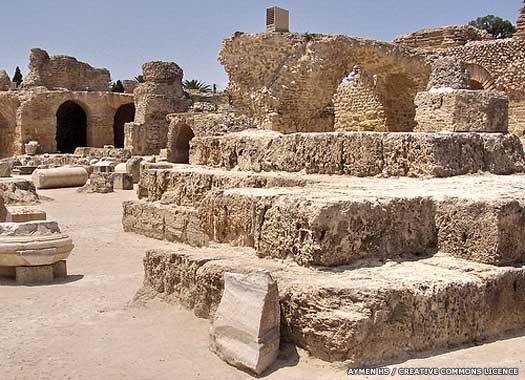 The city of Carthage existed in its original glory for at least four hundred and twenty-eight years before it was destroyed by the Romans - and possibly another two centuries before that as a developing colony which was founded by Phoenicians The city of Carthage existed in its original glory for at least four hundred and twenty-eight years before it was destroyed by the Romans - and possibly another two centuries before that as a developing colony which was founded by Phoenicians |
|
| 580 BC |
Some Greek settlements in Sicily, such as Syracuse, attempt to drive the Phoenicians from Motya and Panormus (Palermo) in the west of the island. The Carthaginians fear that if the Greeks win the whole of Sicily they will next move ontoSardinia and beyond, isolating the Phoenicians in North Africa. The successful defence of Sicily is followed by attempts to strengthen limited footholds in Sardinia. A fortress at Monte Sirai in Sardinia is the oldest Phoenician military building in the west. |
|
| c.540 BC |
The threat from the Greeks recedes when Carthage, in alliance withEtruscan cities, backs the Phoenicians of Corsica and succeeds in excluding the Greeks from contact with colonies such as Gadir in southern Iberia. |
|
| 574 BC |
Carthage becomes independent ofTyre. Although many elements of life and government in Carthage are patterned on those of Tyre, the city does not establish a permanent kingship of its own but is instead governed under 'suffet' or the more widely-used Hebrew 'shoftim', meaning 'judges'. The shoftim of Carthage eventually prove to be both executive power and judicial leaders, but they hold no military power. It appears that each shofet is elected by the citizens, and holds office for a one year term. Quite possibly there are two of them at a time, mirroring the system of consulship later used by Rome. |
|
| c.580 - c.556 BC |
Hanno I |
Of the same family as Mago I, below. |
| c.556 - c.550 BC |
Malchus |
|
| c.550 - c.510 BC |
Mago I |
King of Carthage, and more than a (still minor) shofet. |
| 539 BC |
All of Phoenicia is submerged within thePersian empire. As a result, many Phoenicians emigrate to the colonies, especially Carthage. This city quickly rises to become a major power under the Magonid descendants of Mago, especially under Hanno. Utica quickly becomes a dependency, as do many other Phoenician colonies, which allows the Magonids to monopolise the position of shofet for a century. The Tartessians, however, begin a decline after losing Gadir as their primary export hub. |
|
| c.510 - 499 BC |
Hasdrubaal |
|
| 509 BC |
A century and-a-half of exploitation by the Phoenicians now results in an uprising by the Sardi. The mount a series of attacks against Phoenician settlements, forcing the colonists to call upon Carthage for help. A military force arrives which puts down the uprising and secures most of the island under Carthaginian control. |
|
| c.500 BC |
Carthage now dominates the Phoenician settlement of Gadir, making it a dependency. It is also responsible for the resumption of trade in luxury items along the Atlantic coast of Europe. TheCastro culture of Iberia certainly benefits from this after half a millennium of comparative isolation following the end of the Atlantic Bronze Age, with tribes such as the Cynetes soon becoming dominated by the presence of Carthaginians. The Tartessians, however, are already in terminal decline when their civilisation disappears abruptly around this time. |
|
| 499 - 480 BC |
Hamilcar I |
Grandson of Mago. |
| 480 BC |
Hamilcar lands a huge army in Sicily in order to confront Syracuse (a colony of Corinth) on the island's eastern coast. The Carthaginians are defeated by the Greeks at the Battle of Himera. A long struggle ensues with intermittent warfare between Carthage and Syracuse. 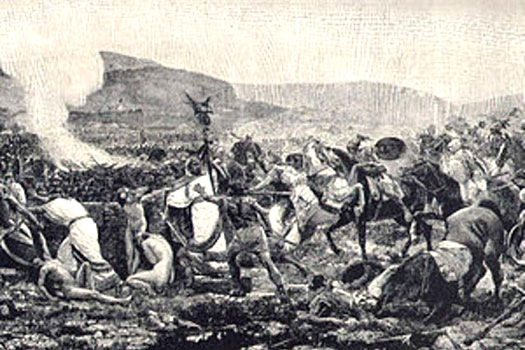 The Carthaginians and Greeks seemed pretty evenly matched in their struggle for dominance of the western Mediterranean - this time around, Hamilcar's defeat on Sicily (shown here in a Victorian print of the event) merely triggered a series of conflicts The Carthaginians and Greeks seemed pretty evenly matched in their struggle for dominance of the western Mediterranean - this time around, Hamilcar's defeat on Sicily (shown here in a Victorian print of the event) merely triggered a series of conflicts |
|
| Probably a direct result of the defeat is that the king is forced to relinquish most of his powers to the Council of Elders, which is made up of the nobility and aristocratic merchant clans, along with the Tribunal of 104. The kings are allowed to remain in place (as little more than figureheads). |
|
|
| 480 - 440 BC |
Hanno II the Navigator |
|
| c.450 BC |
The Barcid family come to prominence as shoftim in the city. |
|
| c.460 - c.410 BC |
Hamilco I |
Ruled the Carthaginian settlement in Sicily. |
| 440 - 406 BC |
Hannibal |
|
| 406 - 396 BC |
Hamilco II |
|
| 396 BC |
 When Hamilco pulls out of Syracuse, abandoning his Iberian Mercenaries, it is the Iberians who survive the subsequent massacre. They group together, march to Syracuse, and offer Dionysius 'the Elder' their services (see feature link). This results in some of them becoming his personal bodyguard while his son, Dionysius II, who sends some of their mounted warriors to aid Sparta. When Hamilco pulls out of Syracuse, abandoning his Iberian Mercenaries, it is the Iberians who survive the subsequent massacre. They group together, march to Syracuse, and offer Dionysius 'the Elder' their services (see feature link). This results in some of them becoming his personal bodyguard while his son, Dionysius II, who sends some of their mounted warriors to aid Sparta. |
|
| 396 - 383 BC |
Mago II Barceus |
|
| 383/382 BC |
Hamilco III |
|
| c.383 BC |
As the aristocracy seizes more power through the Council of Elders, two factions emerge. One is that of the aristocrats under Eshmuniaton, while the other is the military faction under Hanno the Great. Hanno's position is closest to the old notion of 'king'. He rides a wave of popular support as the war with Syracuse is once more renewed and Carthage is gripped by ardent nationalism. |
|
| 383/2-c.382/0 BC |
Eshmuniaton / Suniatus |
A member of the Council of Elders. |
| c.382/380 BC |
Eshmuniaton is disposed of in the courts when he is condemned for treason. Hanno the Great assumes the position of first citizen, or tyrant, over the city. There seems to be some confusion amongst academics over the use of 'Hanno the Great'. There are two of them in this list (in 382 BC and 250 BC, along with a powerful second century BC politician not shown here), and the numbering which had begun with the previous two rulers named Hanno is ignored. Here, the numbering from the previous two Hannos is continued, thereby differentiating the two 'Greats' as Hanno III and Hanno IV, but also showing their alternative numbering in brackets. |
|
| 382 - 360 BC |
Hanno III (I) the Great |
Returned to temporary power in 340. |
| 367 BC |
The war against Syracuse finally comes to an end when Hanno leads a fleet of two hundred ships to a decisive naval victory over the Greeks onSicily. Soon afterwards, Dionysius is apparently poisoned on the orders of his son. |
|
| 360 BC |
Hanno III apparently steps down from his position as head of state (essentially the 'first among equals' rather than fulfilling the role of a king). However, the disasters of 345-340 BC persuade him to return. |
|
| 360 - 344 BC |
Mago III |
|
| 345 - 340 BC |
The Carthaginians launch a large-scale military campaign in Sicily, sending 50,000 infantry backed by cavalry, a large fleet of war chariots, and a large train of siege engines. However, the Greeks of Syracuse receive assistance fromCorinth and the Carthaginian forces are driven out. Mago commits suicide rather than face the Tribunal of 104. Another army is sent, commanded by two generals named Hasdrubal and Hamilcar. This is also defeated, at the Battle of Crimisus, during which the elite 'Sacred Battalion' of three thousand noblemen is annihilated. The defeat is a disaster, ranking as one of Carthage's greatest military disasters. General Hasdrubal is condemned by the Tribunal of 104 and executed. |
|
| 340 - 339 BC |
Hanno III (I) the Great |
Executed for rebellion against the council. |
| 339 BC |
Hanno attempts to overthrow the Council of Elders, first by having them all assassinated and, when this fails, by organising a revolt. This also fails and Hanno is brutally executed, along with most of his family. Remarkably, his son not only survives, but is trusted with executive power in the city state. |
|
| 339 - 330 BC |
Gisco |
Son. |
| 330 - 309 BC |
Hamilcar II |
|
| 310 - 307 BC |
Greek armies from Syracuse under Agathocles invade Cape Bon near Carthage, but with disappointing results. |
|
| 309 - 308 BC |
Bomilcar |
Executed for rebellion against the council. |
| 308 BC |
Bomilcar attempts to overthrow the Council of Elders, unsuccessfully. For his pains he is crucified and the system of monarchy (in its loosest sense in relation to Carthage) is terminated. Carthage adopts a system by which the city state is governed as a form of oligarchic republic. Even so, it remains dominated at frequent intervals by powerful individuals, all of whom are generals. |
|
| Mago Barca |
|
|
| c.300 BC |
The region around the River Avon in the modern city of Bath in Britain is occupied by an unknown people at this time. They could be the ancestors of at least part of the later Dobunni tribe, but no details are known about them. A lucky find of an ancient coin near Bath in 2012 is due to extensive flooding in the region. The coin is dated between 300-264 BC and is most likely to be produced in the Carthaginian colonies on Sardinia. Several similar examples have been found, but only along Britain's coastline, not along a river that is certainly used for trading purposes during the second millennium AD, a use that would seem to date back at least to this period. 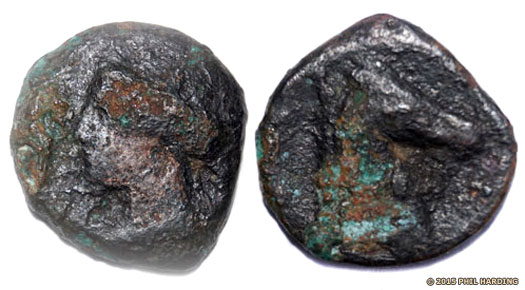 The coin's obverse, left, has an image of Tanit, a Punic and Phoenician goddess, while the reverse, right, has a horse's head - horses were a prized asset with a large swathe of Indo-European peoples which included the Celts who lived in Britain The coin's obverse, left, has an image of Tanit, a Punic and Phoenician goddess, while the reverse, right, has a horse's head - horses were a prized asset with a large swathe of Indo-European peoples which included the Celts who lived in Britain |
|
| While Sardinia is favoured as the coin's place of manufacture, almost any of the Punic empire's colonies could be responsible, including Carthage itself. Clearly trading links exist at this time between the Phoenician colonies and the British Isles, mainly for Britain's tin which is found in large deposits in Devon and Cornwall. Buried in the silt and mud of the Avon's banks for 2,300 years, the coin is generally in poor condition, but its comparative rarity makes it important. |
|
|
| 295 - 250 BC |
Hamilcar |
|
| 275 - 259 BC |
Hannibal the Rhodian |
|
| 264 - 241 BC |
The First Punic War erupts between Rome and Carthage. It starts in Sicily and develops into a naval war in which the Romans learn how to fight at sea and eventually gain overall victory. Carthage loses Sardinia and the western section of Sicily. Carthage also has to quell subsequent dissent from Utica and its neighbouring city of Hippocritae, and the post-Punic Mercenary War in which Carthage's hired troops, mainly Iberian Mercenaries, virtually go on strike for better pay. |
|
| 250 - 241 BC |
Hanno IV (II) the Great |
|
| 241 - 228 BC |
Hamilcar Barca |
|
| 237 BC |
Hamilcar leads an expedition to expand Carthage's interests in Iberia and conquer the native peoples. UsingGadir as his base of operations, he pursues this policy until his death in battle. Hasdrubaal takes command, and pursues a policy of consolidation. WithRome under threat of imminent attack by Gauls in northern Italy, they hurriedly sign a treaty with him whereby both parties agree to maintain the River Ebro as their mutual border, with neither crossing to pursue gains in the other side's territory. However, this means that the Roman settlements in the north pose a potential threat. |
|
| 228 - 221 BC |
Hasdrubaal / Hasdrubal |
Son. Assassinated. |
| 221 - 195 BC |
Hannibal Barca bar Hamilcar |
Brother. Rome's greatest opponent. Died between 183-181 BC. |
| 218 - 202 BC |
The Second Punic War starts at Saguntum (near modern Valencia) in Hispania when the Turboletae assist Carthage in sacking this Edetani city during the final assault. Using Gadir as a base, Hannibal Barca sets out to attack Rome, leading his armies over the Alps into Italy. He has to fight off resistance by Gaulish tribes such as the Allobroges along the way but is supported by other Gauls such as the Insubres, and pre-Gaulish tribes such as the Ingauni. At first he wins great victories at Trasimeno and Cannae which all but destroys Roman military strength, but he is denied the reinforcements to pursue his victory by an opposing political faction back at home. The majority of Rome's Italian allies remain loyal and Rome is able to rebuild its strength. In 206 BC, Gadir is lost. In 203 BC the Carthaginians lose the Battle of the Great Plains when their forces are routed. Their Iberian Mercenaries stand firm and fight to the very end, determined not to be picked off while running away or subjected to the horrors of capture and execution. In 202 BC an enemy force is landed in North Africa, thanks to which Hannibal is defeated by Scipio Africanus at the Battle of Zama, thereby ending the war. 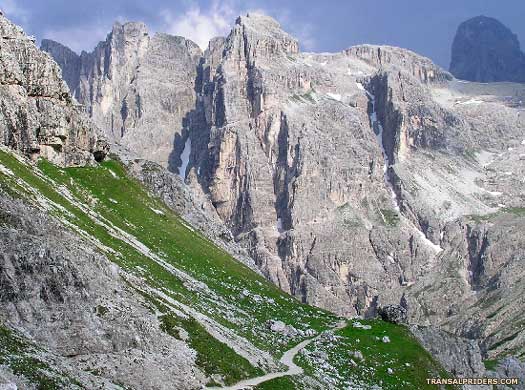 The Celtic tribes of the Western Alps were relatively small and fairly fragmented, but they made up for that with a level of belligerence and fighting ability that often stunned their major opponents, including the Romans The Celtic tribes of the Western Alps were relatively small and fairly fragmented, but they made up for that with a level of belligerence and fighting ability that often stunned their major opponents, including the Romans |
|
| During the war, Philip of Macedonia allies himself to Carthage. To avoid a possible reinforcement of Hannibal by Macedonia, Rome dispatches a force to tie down the Macedonians in the First Macedonian War. The war ends indecisively in 205 BC with the Treaty of Phoenicia. Even though it is only a minor conflict, it opens the way for later Roman military intervention in Greece. |
|
|
| 210s - 206 BC |
Mago Barca |
Brother. |
| 210s - 206 BC |
Hasdrubaal Gisgo |
|
| 201 BC |
A peace treaty is dictated byRome in which Carthage loses its trading cities in Hispania and elsewhere in the western Mediterranean, and much of its influence over the Numidian kingdoms in North Africa. The city's power is reduced to its immediate surroundings, and it owes a large indemnity to Rome. Hannibal is allowed to return to Carthage. |
|
| 196 - 195 BC |
Hannibal is still greatly admired as a Barcid military leader and is now elected shofet. He reforms the government in order to meet the heavy tribute payments demanded by Rome, but when his reforms are blocked by a financial official who is about to become a judge for life, Hannibal rallies the populace against the Tribunal of 104. He proposes a one year term for the 104 as part of a major civic overhaul. His political opponents flee to Rome and charge Hannibal with conspiracy by plotting war against Rome in league with Seleucid king Antiochus III. Although Scipio Africanus resists such manoeuvre, eventual Roman intervention forces Hannibal to flee Carthage for Antioch, handing victory to the corrupt officials. |
|
| 195 - 160 BC |
Hasdrubaal Haedus |
Pro-Roman faction. |
| 183 - 181 BC |
After living for a time in Bithynia, Hannibal is about to be handed over to theRomans. To escape, he commits suicide by taking poison. The exact year of his death is variously reported. |
|
| 160 - 152 BC |
Carthalo the Boetarch |
Democratic faction. |
| 152 - 148 BC |
Hasdrubaal |
|
| 148 - 146 BC |
Hasdrubaal the Boetarch |
Surrendered to Rome. |
| 149 - 146 BC |
Carthage has recovered from its defeat in 202 BC and refuses a change in terms byRome. The Third Punic War sees Rome's armies besieging Carthage which rejects negotiations. Eventually the city is destroyed and its citizens enslaved. The event is witnessed by Polybius, whose record is preserved by Plutarch, although there is something of a feeling of pro-Roman propaganda about it. While the Balearic Islands are left virtually independent, the region around Carthage is annexed to the growing overseas empire of Rome, in the form ofAfrica Proconsularis. |
|
|
|
|
| Roman Africa Proconsularis (Carthage) 40 BC - AD 439 Incorporating the Diocese of Africa The Phoenicians had been born explorers, with tradition ascribing their earliest settlements to the end of the twelfth century BC. Weakening Egyptian domination allowed both their home cities and their colonisation efforts to expand greatly in the eleventh century BC. Conquest of their Levantine cities in the seventh century BC by Assyria did nothing to stop this trend but Babylonian conquest in 573 BC forced many to emigrate to the colonies. Carthage became a major power thanks to this, establishing its own kingship and ruling body. Persian control of Phoenicia from 539 BC saw the massive emigration continue and Carthage became entirely independent of its founder cities. It was only its defeat over the course of three major wars by republican Rome that ended its independence. Following the fall of an independent Carthage, the local North African region was reorganised under Roman control. The city state ofUtica, which became a Roman ally at the start of the Third Punic War, became the regional capital, charged with being Rome's key supplier of Punic trade. However, its main harbour soon proved problematical, as it suffered from an unrelenting build-up of silt that was washed down from the mountains. In time the harbour was rendered useless and Rome was forced to rebuild Carthage. The city became the capital first of Colonia Junonia (44 BC) and then of the province of Africa Proconsularis. (Additional information from Geography, Strabo, the Dictionary of Greek and Roman Geography, William Smith, from the Life of Apollonius of Tyana, from The Prosopography of the Later Roman Empire, Volume III: AD 527-641, John R Martindale, A H M Jones, & John Morris (Cambridge University Press, 1992), from The Oxford Dictionary of Byzantium: Niketas, Walter Emil Kaegi (Alexander P Kazhdan, Ed, Oxford University Press, 1991), and from External Link:Carthage (Ancient History Encyclopaedia), and If it wasn't for a plague, Jonathan Kennedy (The Guardian).) |
|
|
| 146 - 122 BC |
During this period the site of the city of Carthage remains little more than a scattering of ruins. The region is governed fromUtica. The fall of Carthage is described by Polybius, with Roman soldiers 'being ordered to come against the inhabitants of the city with orders to kill all they encountered, sparing none, and not to start pillaging until the signal was given. They do this, I think, to inspire terror...' 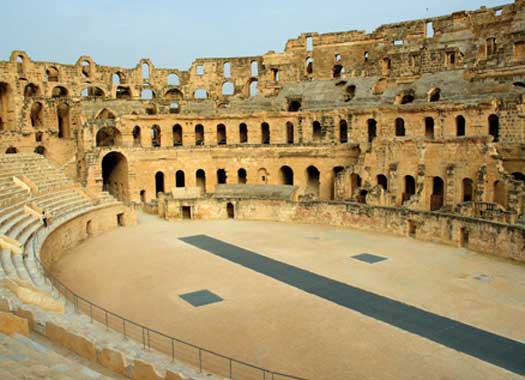 Roman Carthage, when it was finally constructed over the ashes of the original city, was of course bigger and better and even more grand than the original city had been Roman Carthage, when it was finally constructed over the ashes of the original city, was of course bigger and better and even more grand than the original city had been |
|
| 122 - 40 BC |
A Roman tribune by the name of Gaius Sempronius Gracchus founds a colonia on the site of Carthage. The project fails as general Roman sentiment against the ancient enemy state is still too strong, and political manoeuvring against Gracchus blocks the scheme. Carthage is again abandoned and the region remains governed fromUtica. |
|
| 88 - 87 BC |
Publius Sextilius |
|
| 49 - 27 BC |
A new Carthage, Colonia Junonia, is built on the site by Julius Caesar, although construction of it has to be completed after his death in 44 BC. Within five years of that death the city is made the capital of the newRoman province of Africa Proconsularis. The region's ability to serve as the breadbasket of Rome - the initial cause of its success in the first place - ensures its survival. |
|
| 27 BC |
Caesar Augustus (Octavian) becomes a tribune and consular imperium inRome and the empire is born. Africa Proconsularis gains its own governor |
|
| 29 - 3 BC |
? |
Name(s) unknown. |
| c.3 BC |
Gnaeus Calpurnius Piso |
Former consul. Later inHispania (AD 9 or 10). |
| c.3 BC - AD 12 |
? |
Name(s) unknown. |
| 12 - 15 |
Lucius Nonius Asprenas |
|
| 15 - 16 |
Lucius Ælius Lamia |
|
| 16 - 17 |
Aulus Vibius Habitus |
|
| 17 - 18 |
Marcus Furius Camillus |
|
| 18 - 21 |
Lucius Apronius |
|
| 21 - 23 |
Quintus Junius Blaesus |
|
| 23 - 24 |
Publius Cornelius Dolabella |
|
| 24 - 26 |
? |
Name(s) unknown. |
| 26 - 29 |
Caius Vivius Marsus |
|
| 29 - 35 |
Marcus Junius Silanus |
|
| 35 - 36 |
Caius Rubellius Blandus |
|
| 36 - 37 |
Servius Cornelius Cethegus |
|
| 37 - 38 |
? |
Name(s) unknown. |
| 38 - 39 |
Lucius Calpurnius Piso |
Former governor inHispania (c.AD 25). |
| 39 - 40 |
? |
Name(s) unknown. |
| 40 - 41 |
Lucius Salvius Otho |
|
| 41 - 43 |
Quintus Marcius Barea Soranus |
|
| 43 - 44 |
? |
Name(s) unknown. |
| 44 - 46 |
Servius Sulpicius Galba |
Later inHispania. Emperor of[Rome](../KingListsEurope/ItalyRomeEmpire.htm#Soldier Emperors) (68-69). |
| 46 - 47 |
Marcus Servilius Nonianus |
|
| 47 - 51 |
? |
Name(s) unknown. |
| 51 - 52 |
Lucius Tampius Flavianus |
|
| 52 - 53 |
Titus Statilius Taurus |
|
| 53 - 56 |
Marcus Pompeius Silvanus Staberius Flavinus |
|
| 56 - 57 |
Quintus Sulpicius Camerinus Peticus |
|
| 57 - 58 |
Gnaeus Hosidius Geta |
|
| 58 - 59 |
Quintus Curtius Rufus |
|
| 59 - 60 |
? |
Name unknown. |
| 60 - 61 |
Aulus Vitellius |
|
| 61 - 62 |
Lucius Vitellius |
|
| 62 - 63 |
Servius Cornelius Scipio Salvidienus Orfitus |
|
| 64 - 68 |
Titus Flavius Vespasianus / Vespasian |
Emperor ofRome (69-79). |
| 68 |
? |
Name unknown. |
| 68 |
Caius Vipsanius Apronianus |
|
| 68 - 98 |
Roman records of the names of governors breaks here, during the 'Year of the Four Emperors', the first time the imperial selection system breaks down, causing a period of great disturbance. 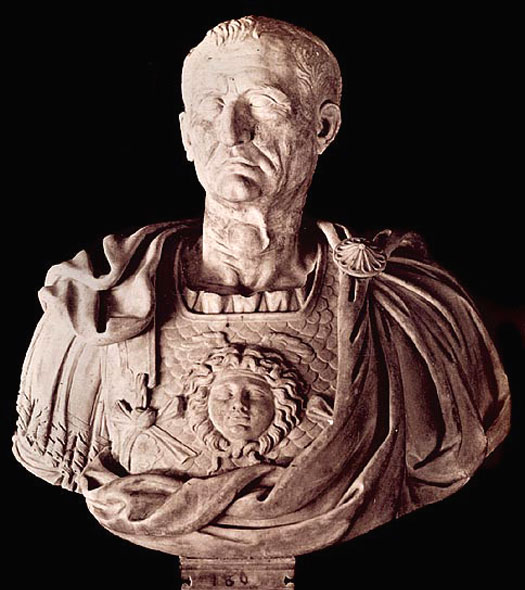 Galba seized Rome and the imperial title in AD 68, but immediately faced opposition by other generals who thought that their claim was better, sparking the 'Year of the Four Emperors' in AD 69 Galba seized Rome and the imperial title in AD 68, but immediately faced opposition by other generals who thought that their claim was better, sparking the 'Year of the Four Emperors' in AD 69 |
|
| 98 - 99 |
Gaius Cornelius Gallicanus |
Formerly inHispania and then Gaul. |
| 121 |
Lucius Minicius Natalis |
|
| 121 - 139 |
? |
Name(s) unknown. |
| 139 - 140 |
[?] Minicius |
Personal name unknown. |
| 140 - 141 |
Titus Prifernius Paetus Rosianus Geminus |
|
| 141 - 142 |
Sextus Julius Maior |
|
| 142 - 143 |
Publius Tullius Varro |
|
| 143 - ? |
? |
Name(s) unknown. |
| [?] Ennius Proculus |
Personal name unknown. |
|
| ? - 153 |
? |
Name(s) unknown. |
| 153 - c.154 |
Lucius Minicius Natalis Quadronius Verus |
|
| c.154 - c.155 |
Marcellus |
Family names unknown. |
| c.155 - c.157 |
Severus |
Family names unknown. |
| c.157 - 158 |
Lucius Hedius Rufus Lollianus Avitus |
|
| 158 - 160 |
[?] Claudius Maximus |
Personal name unknown. |
| 160 - 161 |
[?] Egrilius Plarianus |
Personal name unknown. |
| 161 - 162 |
Titus Prifernius Paetus Rosianus Geminus |
|
| 162 - 163 |
Quintus Voconius Saxa Fides |
|
| 163 - 164 |
Sextus Cocceius Severianus Honorinus |
|
| 164 |
Servius Cornelius Scipio Salvidienus Orfitus |
|
| 164 - 165 |
Marcus Antonius Zeno |
|
| 165 - ? |
? |
Name(s) unknown. |
| 165 |
[Roman](../KingListsEurope/ItalyRomeEmpire.htm#Adoptive Emperors) records of the names of governors largely end here, although the post still exists and remains in place for the remaining life of the empire in North Africa. In 302 records begin again, although they are extremely patchy. |
|
| c.168 - 169 |
Salvius Julianus |
Formerly inHispania (c.161-164). Died c.169. |
| 173/175 |
Gaius Aufidius Victorinus |
Formerly inHispania (c.170-172). |
| 213? - 222? |
Gaius Caesonius Macer Rufinianus |
Formerly inHispania (c.193?-197). In office for 2-3 years. |
| 237 - 238 |
Gordian I (the Elder) |
Proclaimed emperor. Committed suicide. |
| 237 - 238 |
There is widespread discontent at the rule of [Roman](../KingListsEurope/ItalyRomeEmpire.htm#Soldier Emperors Secundas) Emperor Maximinus Thrax. This culminates in a revolt in the province of Africa. Gordian is sent along with his son to resolve the problem, and they enter Carthage as proconsuls only to be greeted with popular enthusiasm. Proclaimed emperor, Gordian I reigns for three weeks from Carthage, sharing power with his son, Gordian II. Both Gordians die when the governor of the neighbouring province of Numidia marches against them and kills Gordan II. His father commits suicide upon hearing the news. |
|
| fl 240 |
Sabinianus |
Usurper in Africa. Defeated by the governor of Mauritania. |
| 240 |
Sabinianus follows Gordian's example and puts in a claim for the imperial throne from Africa. He is defeated by the[Roman](../KingListsEurope/ItalyRomeEmpire.htm#Soldier Emperors Secundas) governor of Mauritania. |
|
| fl 240 |
Caesonius Lucillus |
|
| 251 |
The pandemic known as the Plague of Cyprian hits[ Rome](../KingListsEurope/ItalyRomeEmpire.htm#Soldier Emperors Secundas) and lasts for at least the next two decades. It may be at least partially responsible for the period of political instability and economic disruption which is known as the 'Crisis of the Third Century', and which nearly results in the empire's collapse. Bishop Cyprian of Carthage gives his name to the pandemic, having described symptoms which include high fever, vomiting, diarrhoea, and bleeding from the ears, eyes, nose, and mouth. Based on this account, a viral haemorrhagic fever is most likely, similar to Ebola. According to one chronicle, at its height the pandemic kills five thousand people a day in the capital, while Alexandria's population is estimated to drop from about five hundred thousand to one hundred and ninety thousand. |
|
| ? - 262? |
Memor |
Northern African Roman official, perhaps in Egypt. |
| 262 |
Memor prepares to declare himself[Roman](../KingListsEurope/ItalyRomeEmpire.htm#Soldier Emperors Secundas) emperor in Africa but is killed by General Theodotus. |
|
| 293 |
The crises of the late third century AD prompt Emperor Diocletian to introduce the 'Tetrarchy', along with various administrative reforms. The province of Africa now becomes a diocese. |
|
| 302 |
Roman records of the names of governors begin again, although they are extremely patchy. |
|
| c.302 |
Iulianus (Amnius Anicius Julianus?) |
|
| 315 - 317 |
Petronius Probianus |
|
| 317 - 318 |
Aconius Catullinus |
|
| 337 |
Constantine II emerges from the unsettled period following his father's death as the senior Augustus, controlling Britain, Gaul, and Hispania - the Gallic Provinces. Constans controls Africa, Italy and[Rome](../KingListsEurope/ItalyRomeEmpire.htm#Flavians Secundas), and the Illyrian provinces, while Constantius II holds Constantinople and most of the east. |
|
| 338 - 339 |
Fabius Aconius Catullinus Philomathius |
Vicarius (deputy). Formerly inHispania. |
| 372 - 375 |
The usurpation of Firmus takes place against the Comes Africae, Romanus, who is guilty of accepting bribes in return for protection, He had supported Firmus' illegitimate half-brother when he had tried to seize their late father's wealth. Firmus, who is the son of a Moorish prince and powerful [Roman](../KingListsEurope/ItalyRomeEmpire.htm#Flavians Secundas) officer, has the support of native African tribes, He is undefeated against the emperor's magister militum, Theodosius, until he is betrayed by one of his own supporters. He chooses suicide over capture. |
|
| 395 |
The province of Africa becomes part of the Western Empire. 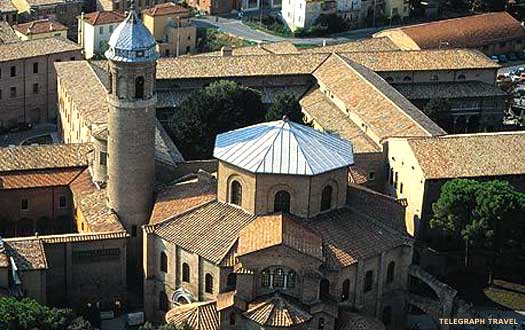 Changes were happening in the empire - Ravenna became an imperial city in 402, and remained Italy's capital under succeeding Gothic, Ostrogothic, and Eastern Roman administrations Changes were happening in the empire - Ravenna became an imperial city in 402, and remained Italy's capital under succeeding Gothic, Ostrogothic, and Eastern Roman administrations |
|
| 396 - 397 |
Anicius Probinus |
|
| 400 - 401 |
Gabinius Barbarus Pompeianus |
|
| 415 |
Aurelius Anicius Symmachus |
Praefectus urbi of Rome in 420. |
| 416 |
 A synod is held in Carthage (the Council of Carthage) in the Roman province of Africa which takes a firm line against the Pelagian 'heresy'. Pelagius (c.354-420/440) is a British ascetic who has allegedly denied the doctrine of original sin and he finds many supporters in Britain, especially amongst the educated classes. A synod is held in Carthage (the Council of Carthage) in the Roman province of Africa which takes a firm line against the Pelagian 'heresy'. Pelagius (c.354-420/440) is a British ascetic who has allegedly denied the doctrine of original sin and he finds many supporters in Britain, especially amongst the educated classes. |
|
| 439 - 534 |
Roman Carthage and Utica are conquered by the invading [ Vandali](../KingListsEurope/BarbarianVandals.htm#Vandals and Alans), who form their own powerful kingdom along the North African coast. The Western Roman empire is unable to recapture the vital province, and it takes until the sixth century before General Belisarius can be sent with an army by the Eastern Roman Emperor Justinian to North Africa. In one campaigning season and two battles, the [ Vandali](../KingListsEurope/BarbarianVandals.htm#Vandals and Alans) are conquered. Carthage is ressurected as the centre of the 'Prefecture of Africa'. |
|
|
|
|
| Byzantine Prefecture & Exarchate of Africa (Carthage) AD 534 - 703 The Phoenicians had been born explorers, with tradition ascribing their earliest settlements to the end of the twelfth century BC. Weakening Egyptian domination allowed both their home cities and their colonisation efforts to expand greatly in the eleventh century BC. Conquest of their Levantine cities in the seventh century BC by Assyria did nothing to stop this trend but Babylonian conquest in 573 BC forced many to emigrate to the colonies. Carthage became a major power thanks to this, establishing its own kingship and ruling body. Persian control of Phoenicia from 539 BC saw the massive emigration continue and Carthage became entirely independent of its founder cities. It was only its defeat over the course of three major wars by republican Rome that ended its independence. The city was destroyed, but was then rebuilt in the first century BC as Roman Africa Proconsularis. In AD 439 imperial Roman Carthage and the colony of Utica were both conquered by the invading [ Vandali](../KingListsEurope/BarbarianVandals.htm#Vandals and Alans). The Vandali controlled Carthage for almost a century until, in response to the usurpation of the Vandal throne by Gelimer, the Eastern Roman General Belisarius was sent to North Africa with an army. In one campaigning season the previously invulnerable Vandali were conquered. North Africa remained firmly in Roman hands, first as the prefecture of Africa (a civil district) and then as the exarchate of Africa (a military district), until it was conquered by the Islamic empire in the seventh century. North Africa apparently provided the template for a general reorganisation of the Byzantine empire under Emperor Heraclius into military districts and themes. Overall administration of the islands of Corsica and Sardinia were also added to this exarchate, while the provinces of Africa Proconsularis, Byzacena, Mauretania Caesariensis, Mauretania Sitifensis, Numidia, and Tripolitania were all inherited from the destruction of the Vandali in 534. (Information by Peter Kessler, with additional information from Geography, Strabo, the Dictionary of Greek and Roman Geography, William Smith, from the Life of Apollonius of Tyana, from The Prosopography of the Later Roman Empire, Volume III: AD 527-641, John R Martindale, A H M Jones, & John Morris (Cambridge University Press, 1992), from The Oxford Dictionary of Byzantium: Niketas, Walter Emil Kaegi (Alexander P Kazhdan, Ed, Oxford University Press, 1991), and from External Link: Carthage (Ancient History Encyclopaedia).) |
|
|
| 534 |
Archelaus |
Commander of the Eastern Roman invasion forces Apr-May. |
| 534 |
Only temporarily in command of the Eastern Roman invasion force, the former praetorian prefect, Archelaus, is given the post of provisioning the army. The invasion fleet is considered to be a small one, perhaps hinting at the limits of Byzantine naval facilities in the Mediterranean, but the forces that General Belisaurius commands are highly professional. The previously powerful [ Vandali](../KingListsEurope/BarbarianVandals.htm#Vandals and Alans) are defeated in a single season and North Africa is under Roman control once again. 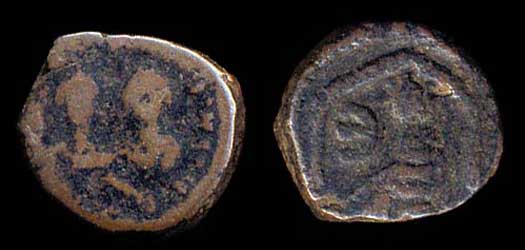 Shown here are two sides of a typical coin issued during the reign of Justin I and then Justinian I of Byzantine Constantinople between AD 518-565, at the very beginnings of restored Roman control of Africa Shown here are two sides of a typical coin issued during the reign of Justin I and then Justinian I of Byzantine Constantinople between AD 518-565, at the very beginnings of restored Roman control of Africa |
|
| 534 |
Belisaurius |
Magister militum, May-Sep. |
| 535 |
Having secured control of Carthage for Romans for the first time in almost a century, General Belisarius proceeds from North Africa to capture sections of Italy, which he reorganises into the Eastern Roman exarchate of Ravenna. |
|
| 534 - 536 |
Salomon / Solomon |
Magister militum & Praetorian prefect (from 535). |
| 534 - 536 |
Having taken over the reigns of power in North Africa, almost immediately Salomon is forced to face and defeat a large-scale incursion by native Berbers. In 536 an attempted assassination and a related mutiny by the army forces him to flee Carthage, although he does return to his post in 539. The mutineers are defeated by Belisaurius during an emergency return to North Africa. |
|
| 536 |
Symacchus |
Praetorian prefect in December. |
| 536 - 539 |
Germanus |
Magister militum. Later appointed to Ravenna? |
| 539 - 543 |
Salomon / Solomon |
Restored as prefect. Killed in battle. |
| 541 - 542 |
The 'Plague of Justinian' strikes Constantinople with the arrival of bubonic plague, probably carried on grain ships from Egypt. Justinian is one of the few to contract the disease and survive, but the rest of the Eastern Roman empire is devastated by it, and critically weakened at the point at which it is about to conquer all of Italy and bring it under the rule of one Roman emperor for the first time since AD 395. It probably also contributes to the rapid rise of the Islamic empire in the following century, as the number of available troops, fighting on many fronts to secure the empire, is too low to contain the Arab tidal wave. |
|
| 543 |
Salomon's second term of office may have started with another notable victory over the Berbers - one which secures the Eastern Roman position in North Africa - but it ends in defeat by the Berbers at the Battle of Cillium. He is succeeded by his nephew, Sergius, who quickly proves to be entirely unsuitable to the position.  Ravenna had been the home of the last Roman emperors, as well as the capital of the succeeding Goths and Ostrogoths, before serving the same role for the Eastern Romans Ravenna had been the home of the last Roman emperors, as well as the capital of the succeeding Goths and Ostrogoths, before serving the same role for the Eastern Romans |
|
| 544 - 545 |
Sergius |
Nephew. Failed and was recalled. |
| 545 |
With the ineffective Sergius being recalled, a senator named Areobindus is sent to North Africa. He has under his command a general named Artabanus, a descendant of the Arsacids of [ Lesser Armenia](../KingListsMiddEast/AnatoliaArmeniaLesser.htm#Lesser Armenia II). Facing a rebellion of the local military forces and aMoorish invasion that is allied to the rebel, Guntherius, Artabanus eventually defeats them all. Areobindus is killed by Guntherius after taking fright and virtually gifting Carthage to the rebels. |
|
| 545 |
Areobindus |
Senator & expedition leader. Murdered by Guntherius. |
| 545 |
Guntherius / Guntharis / Guntharic |
Leader of military uprising. Ruled and assassinated. |
| 545 - 546 |
Anathasius |
Praetorian prefect under Guntherius. |
| 546 |
Artabanus / Artabanes |
Magister militum. Killed Guntherius. Recalled. |
| 546 - 552 |
John Troglita |
Finally pacified the region. |
| 546 - 548 |
As the former dux Mesopotamiae, John Troglita is appointed to assume command in Africa and secure the Eastern Roman hold on the region. The Moors of Byzacena are defeated across the winter of 546-547 but those of Tripolitania reverse John's improved position and raiding resumes. John reorganises his forces, creates alliances with several local tribal leaders, and inflicts a decisive battleground defeat on the Moors at the Fields of Cato in 548. North Africa is safe once again. |
|
| 552 |
Probably amid much celebration across the empire, the death of Totila at the Battle of Taginae allows the city of Rome to be retaken by Constantinople, which governs Italy from Ravenna. The city remains under domination by the Eastern Romans until the eighth century but a civil government slowly emerges to take control of Roman regional affairs in the late ninth century, often vying for power with the pope. Unfortunately the prefecture of Africa remains largely anonymous during this period, as is often the case for Roman districts that are not threatened by war or revolt. 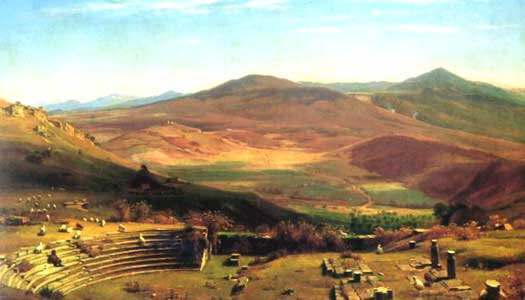 This romantic painting shows the amphitheatre of the Italian city of Tusculum, native territory of what by the end of the ninth century would become the influential counts of Tusculum who dominated the early post-Frankish Roman civil authority This romantic painting shows the amphitheatre of the Italian city of Tusculum, native territory of what by the end of the ninth century would become the influential counts of Tusculum who dominated the early post-Frankish Roman civil authority |
|
| 552 - 555 |
Paul |
Praetorian prefect. |
| 555 - 558 |
Flavius Boethius |
Possibly same as consul of Ostrogothic Rome (522). |
| 558 - 562 |
John Troglita |
Restored. |
| 562 - 563 |
John Rogathinus |
Magister militum. |
| 563 |
John Rogathinus makes the mistake of murdering Cutzinas, an aging tribal leader, when the latter is in Carthage to receive his annual pension. The dead leader's sons and followers rise up, and the tribune Marcian, nephew of the emperor, has to lead an expeditionary force into North Africa to restore peace. |
|
| 563 |
Areobindus |
Praetorian prefect. |
| 563 - 565 |
Marcianus |
Magister militum. |
| 565 |
Thomas |
Praetorian prefect. Returned in 570s. |
| 565 - 569 |
Lucius Mappius |
|
| 569 - 570 |
Theodore |
Praetorian prefect. Killed by Mauro-Romans. |
| 570 - 571 |
Theoctistus |
Magister militum. Killed by Mauro-Romans. |
| 571 |
Troops of the Mauro-Roman kingdom in what had been the Roman province of Mauretania Caesariensis destroy an Eastern Roman army. In fact their ruler, Garmul, is responsible for killing three Roman administrators of Africa in this period. The empire is already being assailed from all sides, what with the Lombards having invaded Italy, and some North African troops have already been sent to active theatres of war, weakening the prefecture's defences. 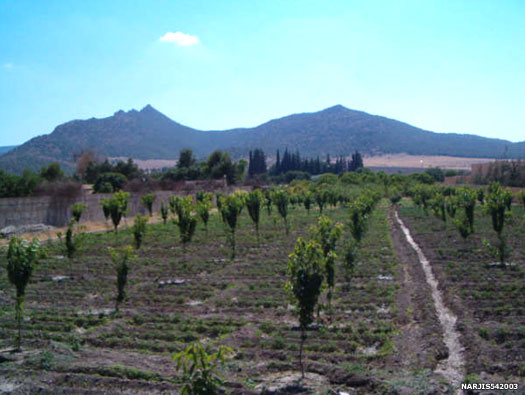 Altava was the capital of the Mauro-Roman kingdom, an ancient city in what is now Algeria which can be found at Ouled Mimoun near Tlemcen on the Roman road from Theveste Altava was the capital of the Mauro-Roman kingdom, an ancient city in what is now Algeria which can be found at Ouled Mimoun near Tlemcen on the Roman road from Theveste |
|
| 571 - 574 |
Amabilis |
Magister militum. Killed by Mauro-Romans. |
| 574 - 578 |
? |
Name unknown. Possibly Thomas, below. |
| 578 |
Thomas |
Reappointed as Praetorian prefect. |
| 577 - 579 |
King Garmul of the Mauro-Roman kingdom invades the prefecture of Africa. With diplomatic ties with the kingdom having broken down, Gennadius is appointed as magister militum Africae under the new prefect, Thomas, to deal with the problem - possibly earlier than 578 as preparations are long and extensive while the campaign is launched in 577. Garmul is swiftly defeated and killed in 579 and his kingdom collapses. Part of it is incorporated into the prefecture while other areas become incorporated into Berber states. |
|
| 578 |
Gennadius (I) |
Magister militum, possibly from 574. Remained after 578. |
| 578 - 579 |
Under Thomas as Praetorian prefect and Gennadius as magister militum, the Mauro-Roman kingdom is destroyed during a short but highly effective campaign that has been under preparation for quite some time. Its ruler, Garmul is defeated and killed by 579. Roman control of the entire region is resumed. |
|
| 578 - 582 |
Vitalius |
Praetorian prefect. |
| 582 - 590 |
Theodore |
Praetorian prefect. |
| 590 - 591 |
John |
Praetorian prefect. |
| 591 - 594 |
Gennadius (I) |
Previously magister militum, now exarch. |
| 591 |
Under Gennadius the prefecture of Africa becomes an exarchate (often, but not permanently it seems. In fact the title may be more of a personal one than one which is attached to the office). The exarch in Africa is the direct military and civil representative of the Eastern Roman emperor, and as such he wields considerable power over the entire western half of the North African coast, the islands (including Sardinia and Corsica), and Iberia. 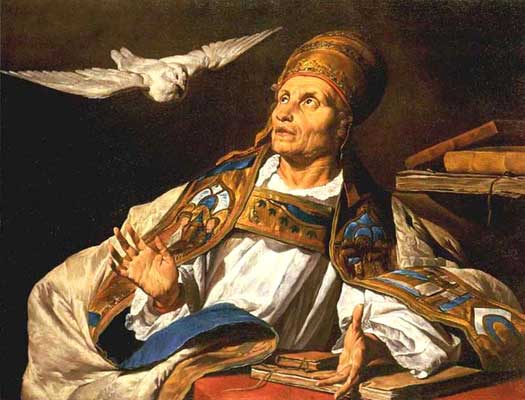 A good telling off by Pope Gregory I was all it took to convert the Barbagians of Sardinia, that and some solid politicking behind the scenes, no doubt A good telling off by Pope Gregory I was all it took to convert the Barbagians of Sardinia, that and some solid politicking behind the scenes, no doubt |
|
| The province of Tripolitania is detached from Africa and given to the province of Egypt, while Mauretania Caesariensis and Mauretania Sitifensis are merged to form the new province of Mauretania Prima. The reduced Mauretania Tingitana, little more than the city of Septum (Ceuta), is combined with citadels along the Spanish coast and the Balearic Islands to form Mauretania Secunda. |
|
|
| 594 - 598 |
Pantaleon |
Exarch. Recalled? |
| c.585 & 596 |
Two serious Berber revolts would seem to be the reason for Gennadius being reappointed as exarch of Africa. Pantaleon's fate is unknown - he is likely either killed while attempting to suppress the latest revolt or is recalled to Constantinople. |
|
| 598 - 600 |
Gennadius (I) |
Reappointed again. Retired. |
| 600 - 602 |
Innocentius |
Praetorian prefect. Temporary posting. |
| 602 - 611 |
Heraclius Crispus 'the Elder' |
Exarch. Father of Eastern Roman Emperor Heraclius. |
| 608 - 610 |
In conjunction with his son, Heraclius the Younger, Exarch Heraclius of Africa (and previously magister militum of [ Armenia](../KingListsMiddEast/AnatoliaArmenia.htm#Governors of Western Armenia)) revolts against the usurper Eastern Roman emperor, Phocas. The younger Heraclius uses Africa as a base from which he is able to overthrow Phocas and begin his own Heraclian dynasty in Constantinople. His father passes away shortly after learning the good news. |
|
| 611 - 614 |
? |
Name unknown. |
| 614 - 617 |
Caesarius |
|
| 617 - 619 |
? |
Name unknown. |
| 619 - 627 |
Nicetas / Niketas |
Exarch? Cousin of Eastern Roman Emperor Heraclius. |
| 619 |
Nicetas is the former exarch of Egypt, forced to flee by the Arab invasion which he had been unable to prevent. He seems not to be mentioned by contemporary sources after that but, thanks to an anecdote which is not accepted by all historians, he is believed to serve as exarch of Africa until his death as he is a firm supporter of Emperor Heraclius. 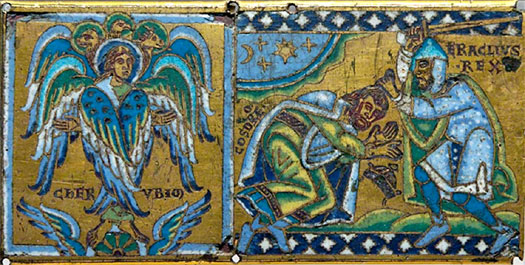 The reign of Heraclius was one of modest success and great catastrophe during which large swathes of territory in North Africa and the Near East were lost while diplomacy and intrigue served to bring the Turkic tribes of the Black Sea coast under a degree of control (the emperor is pictured far right, beheading Khusro II of the Sassanid empire, although it was actually Khusro's own son who overthrew him) The reign of Heraclius was one of modest success and great catastrophe during which large swathes of territory in North Africa and the Near East were lost while diplomacy and intrigue served to bring the Turkic tribes of the Black Sea coast under a degree of control (the emperor is pictured far right, beheading Khusro II of the Sassanid empire, although it was actually Khusro's own son who overthrew him) |
|
| 627 - 633 |
Gregory 'the Patrician' |
Praetorian prefect. A Heraculid by birth. |
| 633 - 641 |
Peter |
Exarch. |
| 640 |
The [ Islamic](../KingListsMiddEast/ArabicIslam.htm#Rightly Guided) invasion of Egypt begins in the later months of 640. A victory at the Battle of Heliopolis delivers much of the country to the Arabs, but the Babylon Fortress (in the region of modern-day Coptic Cairo) has to be besieged for several months before it surrenders. The Eastern Roman capital at Alexandria, capital of Egypt for a thousand years, surrenders a few months later and a peace treaty is signed in late 641 in the ruins of a palace in Memphis. Refugees pour into the exarchate of Africa, alerting both Peter and Gregory to the seriousness of the problem. |
|
| 641 - 648 |
Gregory 'the Patrician' |
Restored. Rebelled in 646. Killed. |
| 645 |
[ Islamic](../KingListsMiddEast/ArabicIslam.htm#Rightly Guided) Egypt is briefly re-conquered by Eastern Roman forces in 645, but the imperial victory is short-lived. Its forces are subsequently defeated at the Battle of Nikiou and Egypt is secured for good by the Arabs. The loss is a disaster for the Romans, while the stream of refugees from Egypt into Carthage is also causing some destabilisation. |
|
| 646 - 647 |
Seemingly making the most of confusion in the empire due to the loss of Egypt, the exarchate of Africa is declared an independent state by Gregory the Patrician, as he throws off the authority of the Eastern Roman Emperor Constans II. The reason is at least partially theological (yet another doctrinal dispute over the nature of Jesus Christ of the likes that have dogged the Papacy for decades), but the exarchate has long been semi-autonomous anyway. He establishes Sufetula (modern Sbeïtla) as his capital as it is further from the coast than is Carthage, and is more secure for that reason. 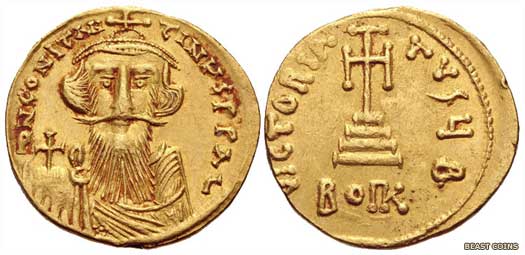 This light solidus was minted during the eventful reign of Eastern Roman Emperor Constans II, with his face on the obverse This light solidus was minted during the eventful reign of Eastern Roman Emperor Constans II, with his face on the obverse |
|
| Gregory's troops are severely defeated by the invading troops of the [ Islamic](../KingListsMiddEast/ArabicIslam.htm#Rightly Guided) empire under the command of Abdullah Ibn Sa'ad of Egypt, and Gregory himself is killed in 648. The exarchate appears to be occupied for perhaps a year or so by the Arabs while the Roman forces hold the fortresses. In 649 the Arabs withdraw, allowing the Eastern Romans to regain some level of control there. The country's interior remains firmly in the hands of the native Berbers, who repel any attempts to subdue them. |
|
|
| 649 - 664 |
The Eastern Roman empire regains control of the exarchate again until 667. It is governed by General Gennadius, seemingly without him being appointed by the emperor. Now continually under threat of invasion by the Arab forces to the east, a more military bias is clearly needed in the region's governance and generally it works. Unfortunately for the empire's security, the Berbers have slipped entirely out of imperial control, reducing the amount that can be gathered in taxes. Gennadius himself rebels in 664, proclaiming Carthage to be independent of Constantinople. |
|
| 648 - 665 |
Gennadius (II) |
Eastern Roman general. Rebelled. Overthrown & expelled. |
| 665 - 667 |
Within a year of rebelling against imperial control, Gennadius is overthrown by loyalists within his own kingdom. He is expelled and flees to the Arabs at Damascus. He is successful in persuading the Islamic caliph to give him an army of reconquest but he dies when they reach Alexandria and the army is temporarily leaderless. The exarchate of Africa is reunited with Constantinople, but the period of unrest has probably distracted imperial troops and resources. In 667 the Islamic empire snatches control of parts of the region, with the wali of Ifriqiyya and the Maghreb launching raids further west. |
|
| 665 - 695? |
Eleutherios the Younger |
Eastern Roman exarch? Uncertain. |
| 686 |
An Islamic force led by Zoheir ibn Kais, wali of Ifriqiyya and the Maghreb, defeats a joint army of Eastern Romans and Berbers that is commanded by Berber leader Khusalah on the Qairawan plain. The victors are not strong enough to follow up their victory with territorial gains. During this period Arabic mentions of one al-At'riyūn are generally attributed to Eleutherios, although there seems to be no other confirmation that he is exarch of Africa. 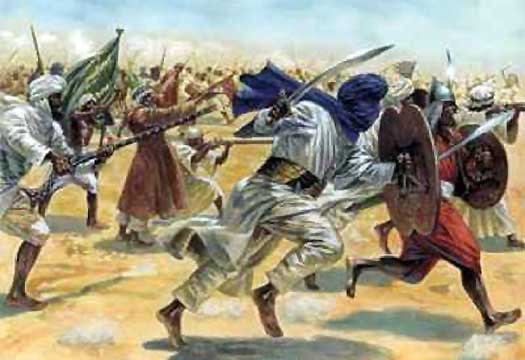 The Arab empire conquered Eastern Roman Carthage through a series of campaigns over the space of half a century, with Roman control over the region gradually weakening during a series of military defeats The Arab empire conquered Eastern Roman Carthage through a series of campaigns over the space of half a century, with Roman control over the region gradually weakening during a series of military defeats |
|
| 695 - 698 |
The Wali of Ifriqiyya and the Maghreb, Hasan ibn al-Nu'man, captures Carthage in 695 and the Eastern Roman administration retreats, possibly to Caralis on Sardinia. Hasan advances into the Atlas Mountains and, taking advantage of his absence, an Eastern Roman fleet arrives to retake Carthage in 697. Within a year Hasan returns and defeats Emperor Tiberius III at the Battle of Carthage. Africa is abandoned to the Islamic empire, except for the small territory of Ceuta (known to the Romans as Septem). It is the last time that Constantinople will rule the region for eight hundred and sixty-six years. Carthage is again destroyed, as is Utica, and is replaced by Tunis as the regional capital. The country itself will eventually bear the same name: Tunisia. |
|
| 695? - 703 |
John 'the Patrician' |
Prefect. In Ceuta/Septem? |
| 703? - 711 |
Julian / Urban / Ulbán / Bulian |
In Ceuta? Possibly a vassal of Roderic of the Visigoths. |
| 710 - 711 |
Ceuta (Septem), and the Pillars of Hercules (the Straits of Gibraltar), are apparently turned over to the Islamic empire by 'Count Julian', as the empire prepares its invasion of Visigothic Iberia. Following the successful invasion, Julian is said to be granted the lands there that he desires, leaving Ceuta in Islamic hands. |
|
 |
|
|

 The city of Carthage existed in its original glory for at least four hundred and twenty-eight years before it was destroyed by the Romans - and possibly another two centuries before that as a developing colony which was founded by Phoenicians
The city of Carthage existed in its original glory for at least four hundred and twenty-eight years before it was destroyed by the Romans - and possibly another two centuries before that as a developing colony which was founded by Phoenicians The Carthaginians and Greeks seemed pretty evenly matched in their struggle for dominance of the western Mediterranean - this time around, Hamilcar's defeat on Sicily (shown here in a Victorian print of the event) merely triggered a series of conflicts
The Carthaginians and Greeks seemed pretty evenly matched in their struggle for dominance of the western Mediterranean - this time around, Hamilcar's defeat on Sicily (shown here in a Victorian print of the event) merely triggered a series of conflicts When Hamilco pulls out of Syracuse, abandoning his Iberian Mercenaries, it is the Iberians who survive the subsequent massacre. They group together, march to Syracuse, and offer Dionysius 'the Elder' their services (see feature link). This results in some of them becoming his personal bodyguard while his son, Dionysius II, who sends some of their mounted warriors to aid Sparta.
When Hamilco pulls out of Syracuse, abandoning his Iberian Mercenaries, it is the Iberians who survive the subsequent massacre. They group together, march to Syracuse, and offer Dionysius 'the Elder' their services (see feature link). This results in some of them becoming his personal bodyguard while his son, Dionysius II, who sends some of their mounted warriors to aid Sparta. The coin's obverse, left, has an image of Tanit, a Punic and Phoenician goddess, while the reverse, right, has a horse's head - horses were a prized asset with a large swathe of Indo-European peoples which included the Celts who lived in Britain
The coin's obverse, left, has an image of Tanit, a Punic and Phoenician goddess, while the reverse, right, has a horse's head - horses were a prized asset with a large swathe of Indo-European peoples which included the Celts who lived in Britain The Celtic tribes of the Western Alps were relatively small and fairly fragmented, but they made up for that with a level of belligerence and fighting ability that often stunned their major opponents, including the Romans
The Celtic tribes of the Western Alps were relatively small and fairly fragmented, but they made up for that with a level of belligerence and fighting ability that often stunned their major opponents, including the Romans Roman Carthage, when it was finally constructed over the ashes of the original city, was of course bigger and better and even more grand than the original city had been
Roman Carthage, when it was finally constructed over the ashes of the original city, was of course bigger and better and even more grand than the original city had been Galba seized Rome and the imperial title in AD 68, but immediately faced opposition by other generals who thought that their claim was better, sparking the 'Year of the Four Emperors' in AD 69
Galba seized Rome and the imperial title in AD 68, but immediately faced opposition by other generals who thought that their claim was better, sparking the 'Year of the Four Emperors' in AD 69 Changes were happening in the empire - Ravenna became an imperial city in 402, and remained Italy's capital under succeeding Gothic, Ostrogothic, and Eastern Roman administrations
Changes were happening in the empire - Ravenna became an imperial city in 402, and remained Italy's capital under succeeding Gothic, Ostrogothic, and Eastern Roman administrations A synod is held in Carthage (the Council of Carthage) in the Roman province of Africa which takes a firm line against the Pelagian 'heresy'. Pelagius (c.354-420/440) is a British ascetic who has allegedly denied the doctrine of original sin and he finds many supporters in Britain, especially amongst the educated classes.
A synod is held in Carthage (the Council of Carthage) in the Roman province of Africa which takes a firm line against the Pelagian 'heresy'. Pelagius (c.354-420/440) is a British ascetic who has allegedly denied the doctrine of original sin and he finds many supporters in Britain, especially amongst the educated classes. Shown here are two sides of a typical coin issued during the reign of Justin I and then Justinian I of Byzantine Constantinople between AD 518-565, at the very beginnings of restored Roman control of Africa
Shown here are two sides of a typical coin issued during the reign of Justin I and then Justinian I of Byzantine Constantinople between AD 518-565, at the very beginnings of restored Roman control of Africa Ravenna had been the home of the last Roman emperors, as well as the capital of the succeeding Goths and Ostrogoths, before serving the same role for the Eastern Romans
Ravenna had been the home of the last Roman emperors, as well as the capital of the succeeding Goths and Ostrogoths, before serving the same role for the Eastern Romans This romantic painting shows the amphitheatre of the Italian city of Tusculum, native territory of what by the end of the ninth century would become the influential counts of Tusculum who dominated the early post-Frankish Roman civil authority
This romantic painting shows the amphitheatre of the Italian city of Tusculum, native territory of what by the end of the ninth century would become the influential counts of Tusculum who dominated the early post-Frankish Roman civil authority Altava was the capital of the Mauro-Roman kingdom, an ancient city in what is now Algeria which can be found at Ouled Mimoun near Tlemcen on the Roman road from Theveste
Altava was the capital of the Mauro-Roman kingdom, an ancient city in what is now Algeria which can be found at Ouled Mimoun near Tlemcen on the Roman road from Theveste A good telling off by Pope Gregory I was all it took to convert the Barbagians of Sardinia, that and some solid politicking behind the scenes, no doubt
A good telling off by Pope Gregory I was all it took to convert the Barbagians of Sardinia, that and some solid politicking behind the scenes, no doubt This light solidus was minted during the eventful reign of Eastern Roman Emperor Constans II, with his face on the obverse
This light solidus was minted during the eventful reign of Eastern Roman Emperor Constans II, with his face on the obverse The Arab empire conquered Eastern Roman Carthage through a series of campaigns over the space of half a century, with Roman control over the region gradually weakening during a series of military defeats
The Arab empire conquered Eastern Roman Carthage through a series of campaigns over the space of half a century, with Roman control over the region gradually weakening during a series of military defeats